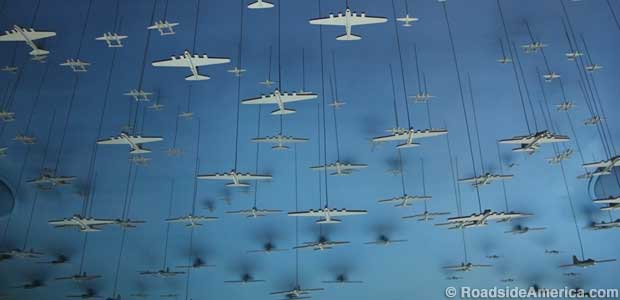
Bombers on strings over Normandy.
National WWII Museum
New Orleans, Louisiana
Finding a hometown for a "national" museum for a big American war is like going into combat: whoever is most aggressive usually wins. Harrisburg, Pennsylvania, grabbed the Civil War; Kansas City, Missouri, snagged World War I; and now New Orleans occupies World War II.
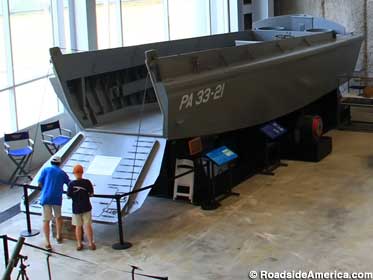
Higgins landing boat, designed and built in New Orleans, made D-Day possible.
New Orleans' National WWII Museum opened in 2000 as the National D-Day Museum, based on the reasonable link that D-Day's amphibious boats were designed and built in New Orleans. But with no apparent opposition, the D-Day Museum has brazenly ballooned into an attraction covering all 1,300+ days of the war, depending on where you mark its beginning and end. Talk about mission creep.
World War II was the world's biggest war, and the National WWII Museum is now America's biggest war museum, a brain-numbing expanse of exhibits spread across multiple buildings, filling a city block. It is bewildering and endless, much as we imagine WWII was to the people who fought it, although we don't think the similarity was intended. You reach the wall-size "Japan Quits!" newspaper and think you've made it, but...oops. Three more buildings to go.
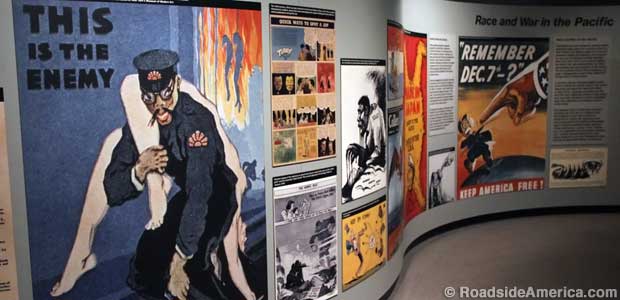
Serpentine wall of anti-Japanese war propaganda.
Most visitors begin by watching a 4-D multimedia show, "Beyond All Boundaries," in the museum's Victory Theater. Wind blows, smoke billows, and explosions rock the seats as Tom Hanks soberly narrates and sad music plays at appropriate moments. It's a fitting gateway into a museum that wows you with Hollywood staging. Video screens and oral history stations and animated maps and "immersive" galleries are everywhere.
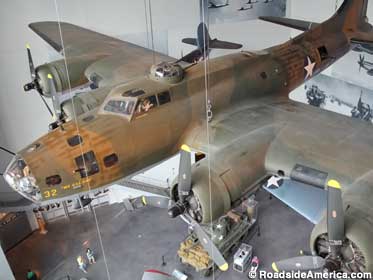
Bird's-eye view, at the top of a very long flight of stairs, of a B-17 Flying Fortress.
For a national museum, however, there really isn't much in the way of key artifacts (the same is true of the national Civil War and World War I museums) -- but maybe most of the wow-factor stuff was already grabbed by the Smithsonian and the West Point Museum. Instead, this museum is all about leveling: presenting the war as experienced by everyday men and women, exhibiting objects such as the wristwatch worn by a recipient of the Distinguished Service Cross, and a wallet carried by a Medal of Honor winner. These common-man items further reinforce the need for dazzling displays, but the museum says that this "stimulation" is simply what's needed nowadays to interest the young.
Like the Titanic Museum, the National WWII Museum assigns to you a particular person (with an electronic "dog tag") whose progress you follow through the war. Surprisingly, you have a much better chance of staying alive as a U.S. WWII combatant than you would have had as a passenger on the Titanic. As one display early in the museum makes graphically clear, the U.S. suffered over a half-million deaths, but Japan had over 3 million and Germany almost 9 million.
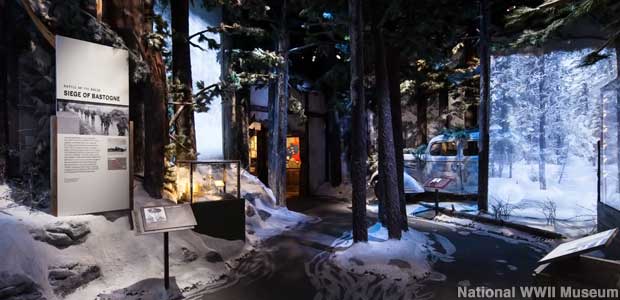
The air conditioning is cranked up in the chilly Battle of the Bulge gallery.
Fans of immersion will enjoy the train car that recreates tearful farewells of Americans leaving for war, and the bombed Air Force quonset hut with fighter planes soaring overhead on a projected sky. Our favorite spot, however, was the "Boeing Center" pavilion, with real WWII aircraft (the museum calls them "macro-artifacts") hung from the lofty ceiling and a very long staircase that you can climb to get a bird's-eye view. Set into one wall are giant video screens showing footage of B-52 bombers and a suit-wearing Boeing executive extolling the patriotism of the corporation.
The time has long passed for anyone to ask, "Why New Orleans?" when discussing the National WWII Museum. It's here, and with its impressive list of multi-million-dollar donations, it's not going anywhere else. The museum plans to complete its elaborate six-acre campus while there are still World War II vets alive to see it, but its mission is to dazzle generations of visitors even after the Greatest one is gone.





